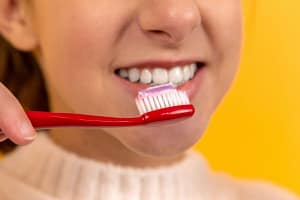Maintaining good dental health is crucial for both a healthy smile and overall well-being.
Good dental hygiene practices, combined with regular visits to the dentist, can help prevent common dental problems such as cavities, gum disease, and bad breath.
In this article, we’ll explore the importance of dental health, provide tips for maintaining a optimal oral health.
Whether you’re looking to prevent dental problems or improve the appearance of your smile, this guide will help you on your journey to good dental health.
So, let’s dive in and show you all you need to know.
The Best Way To Brush Your Teeth For Good Dental Health
 Here’s what the experts recommend.
Here’s what the experts recommend.
First, hold the toothbrush against your teeth at a 45-degree angle and use gentle circular motions to brush the fronts, backs, and tops of your teeth.
Use the tip of the brush to clean the inside surfaces of your front teeth, using a gentle up-and-down stroke.
Brush your tongue or use a tongue scraper to remove bacteria and freshen your breath.
Brush for two minutes, making sure to reach all surfaces of your teeth. Most people spend far less than two minutes.
It’s also important to replace your toothbrush every three to four months or when the bristles start to fray.
How To Prevent Cavities
The first thing you want to do is to make sure your brush teeth twice a day with a fluoride toothpaste.
Then floss daily to remove plaque and food particles from between your teeth and gumline. After that you should use an antiseptic mouthwash to kill bacteria and freshen breath.
During the day limit sugary and acidic foods and drinks, and drink plenty of water to rinse the mouth and keep saliva flowing. Chewing sugar-free gum is another way to increase saliva flow and neutralize acids.
Consider dental sealants or fluoride treatments, especially for children.
Another thing that will really help is to avoid tobacco products of all kinds.
Remember that preventing cavities is a continuous process and requires a commitment to maintaining good oral hygiene.
And don’t forget to visit your dentist regularly for cleanings and check-ups.
Ways To Whiten Your Teeth
 The first way you can whiten your teeth is by taking a trip to the dentist, but this option can be expensive. A dentist can provide in-office whitening or custom-fit whitening trays for at-home use. This may be the most effective, and quickest, way to whiten teeth.
The first way you can whiten your teeth is by taking a trip to the dentist, but this option can be expensive. A dentist can provide in-office whitening or custom-fit whitening trays for at-home use. This may be the most effective, and quickest, way to whiten teeth.
Over-the-counter whitening products such as whitening toothpastes, strips, gels, and trays are available without a prescription. These products may be less effective than professional whitening, but can still produce good results.
Some people like to use home remedies that include baking soda, hydrogen peroxide, or coconut oil to whiten teeth, but the effectiveness of these methods may not give you the results you would hope for.
You can also try using whitening rinses that can help to remove surface stains and freshen breath, or brush with activated charcoal, which is a natural teeth whitener that can help to remove surface stains.
Another thing you can do at home is oil pulling. It involves swishing oil, such as coconut oil, in your mouth for several minutes. This can help to remove surface stains and freshen breath.
Here are some additional things you should do to maintain whiter teeth.
• Limit acidic foods and drinks: Acidic foods and drinks, such as citrus fruits and vinegar, can cause tooth enamel to become more porous, allowing stains to penetrate more deeply. Limiting these types of foods and drinks can help to prevent staining.
• Diet: Eating crunchy fruits and vegetables, such as apples and carrots, can help remove surface stains. As mentioned earlier, chewing gum can also stimulate saliva production, which helps clean the mouth and remove stains.
• Avoid stain-causing products: Reduce or eliminate consumption of stain-causing products, such as coffee, tea, red wine, and tobacco.
It’s important to note that teeth whitening only works on natural tooth enamel and will not change the color of fillings, crowns, or veneers.
It may go without saying, but practicing good oral hygiene – like brushing and flossing regularly – can help to remove surface stains and prevent the buildup of bacteria in the mouth, which can cause bad breath and yellowing of the teeth.
Consult with a dental professional to determine the best whitening method for you and to ensure the safety and effectiveness of the treatment.
Warning Signs Of Gum Disease
Following are some of the things you should look for that indicate you need to see your dentist about possible gum disease.
• Bleeding gums: Gums should not bleed when brushing or flossing. Bleeding gums can be a sign of gum disease.
• Red or swollen gums: Gums that are red, swollen, or tender can be a sign of gum disease.
• Receding gums: If your gums are receding, this can indicate gum disease and a loss of supporting bone around the teeth.
• Persistent bad breath: Bad breath that cannot be relieved by brushing or using mouthwash can be a sign of gum disease.
• Loose teeth: Loose teeth can be a sign of gum disease, as well as a loss of supporting bone around the teeth.
• Changes in bite: Changes in the way the teeth fit together when biting can be a sign of gum disease and a loss of supporting bone around the teeth.
• Pus between the teeth and gums: Pus between the teeth and gums is a sign of infection and can indicate gum disease.
If you are experiencing any of these warning signs of gum disease, it is important to see a dental professional for a proper diagnosis and treatment.
Gum disease is treatable in its early stages, but left untreated, it can lead to tooth loss and other serious health problems.
How To Prevent Gum Recession
Some of the following have been mentioned before, but they bear repeating.
Brush and floss on a regular basis. Brushing twice a day and flossing daily can help remove plaque and prevent gum disease.
Use a soft-bristled toothbrush because hard-bristled toothbrushes can damage the gum tissue and contribute to gum recession.
Avoid aggressive brushing. Brushing too hard or using a toothbrush with bristles that are too stiff can damage the gum tissue and contribute to gum recession.
Use an antiseptic mouthwash to help kill bacteria and prevent gum disease.
Don’t smoke or use tobacco products. Doing so can increase the risk of gum disease and gum recession.
Do your best to control chronic health conditions (such as diabetes) because thay can increase the risk of gum disease and gum recession.
And don’t forget to visit your dentist regularly. Regular dental check-ups and cleanings can help detect gum disease early and prevent gum recession.
If you have gum recession, or are concerned about it, a dental professional can give you a proper diagnosis and treatment.
In some cases, gum recession can be reversed, and in other cases, it can be managed to prevent further progression.
Managing Sensitive Teeth

You should also avoid very hot or cold foods and drinks, and limit your intake of acidic foods and drinks.
Use a soft-bristled toothbrush and brush gently.
Avoid brushing immediately after eating or drinking acidic foods, and use a fluoride rinse or gel to strengthen tooth enamel.
You may also want to consider getting dental treatments such as bonding, crowns, or a fluoride varnish.
To avoid teeth grinding (bruxism) you can wear a night guard, if necessary.
Ask your dentist about other treatments, such as a dental desensitizing agent.
If you have persistent sensitivity, go see your dentist to determine the underlying cause and the best course of treatment.
The Causes Of Bad Breath
Bad breath, also known as halitosis, can be caused by a number of factors, including:
• Poor oral hygiene: Bacteria buildup in the mouth can cause bad breath. Brushing, flossing, and using mouthwash can help reduce bacteria and freshen breath.
• Food: Certain foods, such as garlic and onions, can cause bad breath. Tobacco use can also cause bad breath, as well as stain the teeth.
• Dry mouth: Saliva helps wash away food particles and bacteria in the mouth. When the mouth is dry, bacteria can thrive and cause bad breath.
• Medical conditions: Certain medical conditions, such as gum disease, sinusitis, and acid reflux, can cause bad breath.
• Medications: Certain medications, such as antihistamines, can cause dry mouth, which can lead to bad breath.
• Alcohol consumption: Drinking alcohol can cause dry mouth, which can lead to bad breath.
• Dental problems: Decay or cavities, gum disease, and dentures that do not fit properly can also cause bad breath.
If you are concerned about bad breath, it is important to maintain good oral hygiene and drink plenty of water.
In some cases, bad breath may be a symptom of a more serious underlying condition, so it is important to address it promptly.
The Best Foods For Good Dental Health
If you want to keep your mouth healthy, here are some foods you can add to your grocery list.
• Calcium-rich foods: Foods high in calcium, such as milk, cheese, and yogurt, can help strengthen teeth and keep them healthy.
• Crunchy fruits and vegetables: Fruits and vegetables with a crunch, such as apples, carrots, and celery, can help clean teeth and stimulate saliva production, which helps neutralize acid in the mouth.
• Fluoride-rich foods: Fluoride can help strengthen teeth and prevent cavities. Foods high in fluoride include seafood, such as salmon and sardines, and black and green tea.
• Probiotic-rich foods: Probiotics, such as those found in yogurt and other fermented foods, can help maintain a healthy balance of bacteria in the mouth.
• Foods high in vitamin D: Vitamin D helps the body absorb calcium, which is important for healthy teeth. Foods high in vitamin D include fatty fish, such as salmon, and eggs.
• Sugar-free gum: Chewing sugar-free gum after eating can help stimulate saliva production and neutralize acid in the mouth.
• Water: Drinking water can help rinse away food particles and neutralize acid in the mouth.
Please keep in mind that while these foods can contribute to oral health, a balanced diet and good is also important for maintaining healthy teeth and gums.
Home Remedies To Relieve A Toothache

• Salt water rinse: Rinse your mouth with warm salt water to help reduce inflammation and pain.
• Clove oil: Apply a few drops of clove oil to a cotton ball and place it directly on the affected tooth. Clove oil has antiseptic and numbing properties that can help relieve toothache.
• Garlic: Crush a garlic clove and place it directly on the affected tooth. Garlic has antimicrobial properties that can help reduce pain and inflammation.
• Cold compress: Apply a cold compress, such as a bag of frozen peas, to the outside of your cheek near the affected tooth to help reduce swelling and numb the pain.
• Hydrogen peroxide rinse: Rinse your mouth with a mixture of hydrogen peroxide and water to help kill bacteria and reduce pain.
Keep in mind that these remedies are for temporary relief only and do not replace the need for proper dental care.
If the toothache persists, or is accompanied by other symptoms, such as a fever or swelling, it’s important to see a dentist as soon as possible.
How Often Should You See Your Dentist
The most common recommendation is that you should see your dentist at least twice a year, for a routine cleaning and check-up.
This frequency can vary depending on individual needs and the recommendation of the dentist.
For example, someone with good oral health and no cavities may only need to visit once a year, while someone with gum disease or a history of cavities may need to visit more frequently.
If a person experiences any oral health problems, such as pain, swelling, or tooth sensitivity, they should schedule an appointment with their dentist as soon as possible.
Regular dental check-ups and cleanings are important for maintaining good health and catching any problems early, when they are easier to treat.
Conclusion – Good Dental Health
There you have it – a comprehensive guide to maintaining a healthy, happy smile.
Remember, taking care of your teeth and gums requires a commitment to a daily oral hygiene routine and regular visits to the dentist.
But the payoff is well worth it.
Not only will you have a brighter, healthier smile, but you’ll also lower your risk of more serious dental problems down the road.
So go ahead and show the world those pearly whites – they’re worth the effort.
Happy brushing and flossing!
- Prostate Issues 101 – Causes, Symptoms & Treatments - February 9, 2023
- Brushing Up On Dental Health – The Ultimate Guide To A Dazzling Smile - February 6, 2023
- How To Overcome Social Anxiety Disorder - August 20, 2020
